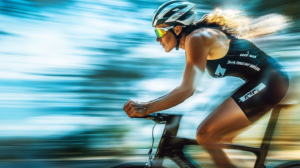
Aging doesn’t mean you have to lose your competitive edge—especially in triathlon. Your body goes through changes as the years go by, but the good news is that with the right strategy, you can continue to improve, stay fit, and even enjoy a triathlon more than ever. Whether you’re noticing small changes or preparing for the long term, these seven detailed tips will help you maintain peak performance well into your later years.
Recovery is where your body repairs and strengthens itself; as you age, this process takes more time. Recovery isn’t just about resting—it’s about giving your body what it needs to bounce back stronger. Incorporate more rest days into your schedule to allow your muscles and joints to fully recover. Active recovery—like easy swims, walks, or light cycling—can keep your blood flowing without overtaxing your muscles. Also, consider investing in recovery tools like foam rollers, massage guns, and compression garments. These can help reduce muscle soreness and prevent injuries. Cryotherapy, cold baths, and infrared saunas are also fantastic for reducing inflammation and aiding in quicker recovery. Finally, sleep is your secret weapon: aim for 7-9 hours of deep, quality sleep every night to ensure your body has the time it needs to recover. Without proper rest, overtraining can lead to injuries that could sideline you longer than expected.
As you age, your muscle mass and strength naturally decline, a condition called sarcopenia. The key to slowing down this process is regular strength training. It’s not enough to rely solely on swimming, biking, and running; you need to challenge your muscles with resistance training. Exercises like squats, deadlifts, lunges, and push-ups target the large muscle groups that support your triathlon performance. Incorporate functional movements that mimic the motions of swimming, cycling, and running. Strengthening your core is especially important for older athletes as it improves stability and power across all triathlon disciplines. And don’t shy away from lifting heavier weights—research shows that lifting heavier with fewer reps is more effective for older athletes looking to build and maintain muscle mass. Aim for at least two strength sessions a week, and don’t forget to warm up properly to protect those aging joints!
As you age, your metabolism slows down, and you become more prone to weight gain and inflammation. To keep performing at your best, your diet needs to support your energy levels, recovery, and overall health. Prioritize lean proteins like chicken, fish, eggs, and plant-based sources like beans and lentils to promote muscle repair. Your protein needs actually increase with age, so aim for around 1.5 to 2.0 grams of protein per kilogram of body weight to help preserve muscle mass. Antioxidants are another must—foods like berries, leafy greens, and nuts help fight inflammation, which becomes more of a concern as you age. Omega-3 fatty acids found in fish, flaxseeds, and walnuts can also reduce joint pain and improve heart health, which is crucial for endurance athletes. Stay well-hydrated by drinking water throughout the day, and make sure to replenish lost electrolytes after long training sessions. Hydration needs change as your body’s ability to regulate fluids decreases, so monitor your intake carefully.
Train Smarter, Not Harder—Adjust for Aging
When you’re younger, you can often get away with pushing yourself hard in training. But as you age, your body doesn’t respond to stress the same way, and training the way you did in your 20s and 30s can lead to overtraining, burnout, or injury. Instead of logging endless miles at high intensity, focus on the quality of your workouts. Work with a coach or use a structured plan that includes periodization—a method of cycling through different training phases, each with its own intensity and volume. High-intensity interval training (HIIT) sessions are still beneficial, but balance them with low-intensity, longer endurance sessions that are easier on the body. Make sure to include rest days and light recovery sessions to avoid fatigue and injury. Listen to your body; if it’s asking for a break, take it. Recovery is just as important as training, especially as you get older.
Maintaining flexibility becomes more challenging as you age, and this can lead to stiffness, reduced range of motion, and a higher risk of injury. Regular stretching and mobility exercises are crucial to keeping your muscles and joints supple. Incorporate dynamic stretches, which involve movement and can be done as part of your warm-up, to prepare your muscles and joints for exercise. Post-workout, focus on static stretching—holding stretches for longer periods—to relax the muscles and improve flexibility. Yoga and Pilates are excellent for improving both flexibility and core strength, two areas that are essential for triathletes. Focus especially on key areas like your hip flexors, hamstrings, shoulders, and lower back—these muscles are under constant strain in all three disciplines (swim, bike, and run). The more flexible and mobile you are, the more efficiently you can move through the water, pedal on the bike, and run with better form.
One of the biggest advantages today’s older athletes have is access to cutting-edge technology that can track and improve performance. Use tools like GPS watches, heart rate monitors, and power meters to gauge your efforts in real time. Data is your best friend when it comes to aging gracefully in the sport. For example, heart rate variability (HRV) can tell you how well your body is recovering, helping you avoid overtraining. Programs like TrainingPeaks allow you to analyze long-term trends in your training and performance, ensuring that you’re on the right track without pushing yourself too hard. Power meters for the bike and run give you objective data on your efforts, helping you dial in the right intensity for each workout. Use this information to train smarter, not harder, and avoid the risk of burnout or injury as you age.
As you age, maintaining motivation and mental toughness can be just as important as your physical conditioning. Set new, realistic goals to keep yourself excited about the sport. These goals don’t always have to be race-oriented—they could be about improving your swim technique, mastering a new strength exercise, or even maintaining a consistent training schedule. Mindfulness and mental strategies can also play a huge role in your performance. Consider incorporating techniques like visualization, where you mentally rehearse your races or workouts, and meditation, which can help manage stress and improve focus. Staying positive and mentally flexible is key as your body changes. Remember, aging is inevitable, but your mindset is something you can always control. Stay open to new approaches, and celebrate the small victories along the way.
Staying in top shape as a triathlete while getting older doesn’t mean giving up—it means adapting. By focusing on smarter recovery, strength training, tailored nutrition, quality training, flexibility, technology, and mental toughness, you can continue to perform at your best. These small changes will keep you at the top of your game and help you enjoy triathlon for many years to come. Embrace the journey, train smart, and remember that age is just a number!

